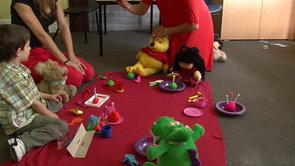Play and Therapy
The importance of play and playing
Play is an important part of every child’s life and skills learned through play are essential to development across a range of areas. For children with ASD, learning how to play is particularly important as there are often gaps in the natural stages of play development due to the nature of ASD.
There are different types of play and it is important that your child has opportunities to engage in all types of play, with a range of objects and equipment, and where necessary facilitated by a good ‘play role-model’ such as a therapist. Play is complex, involving many different skills often overlooked by adults. The need for explicit teaching of the different skills involved in play may be necessary for children with ASD who have difficulty learning by imitation alone.
Playing creates a safe place where your child can experience situations that are not always on their terms, making it an excellent way to address restricted interests and practice social skills. Through play, children learn how to socially interact with others, they discover the enjoyment of learning new things and playing with peers, and they learn about how they fit into the world.
Types of play
Play is a broad term often used to describe many types of play including:
- Manipulative and exploratory play: when children explore objects, toys, and their environment. They are learning how their body can be used to change the environment and how to use their hands and fingers to manipulate objects.
- Sensory play: playing with objects that have different types of smells or sounds or texture (soft, hard, smooth, rough, wet, dry, slimy, furry etc.). This type of play helps children understand and interpret sensory information from their environment.
- Pretend play: giving meaning to imaginative play scenarios including imitation of everyday events (e.g. pretend eating or drinking at a tea-party or pushing a train and picking up passengers along the way). Pretend play also includes using an object to represent something else (e.g. pushing a block across the floor pretending it is a car). This type of play is linked to language development, self-regulation, and social understanding. Through pretend play children can improve their language (number of words and use of words/phrases in different contexts).
How a therapist might use play in therapy
A therapist might use play in therapy in two main ways.
The first is when your child is working on developing different play skills as part of their therapy plan. Pretend play, in particular, is often a missing ability in children with ASD and they need to be explicitly taught how to play. When learning how to play is the focus of therapy, the therapist and child (and maybe the parent) are on the floor and the therapy session is focussed on play sequences such as the child having a cup of tea with the therapist, or pushing a truck and parking it, or using a car mat with one or two cars, or playing shops. When therapy focusses on the play, changes in language and social turn taking also begin to occur alongside the child’s increasing play skills.
The second way a therapist might use play is as a means to engage your child in other activities that are the focus of their therapy.
For example, a therapist might teach your child how to play with different tactile objects as a way to help them tolerate a range of sensory feelings on their skin. Play is a powerful motivator when trying to engage children in new or challenging activities and it can also help to extend your child’s level of focus or attention during an activity.
The importance of parents learning to play with children at home
Children like to spend special times with their parent and playing with your child at home can be one of those special times. Because children with ASD may not naturally enjoy play, you need to demonstrate or ‘model’ your enthusiasm for play. You can show excitement through the use of your voice, facial expressions, and gestures. You can encourage your child to join you in playing. Children often initially engage in play only because they are following you. However, as you repeat the play activity several times while your child is interested, your child will begin to understand that the play itself can be fun and interesting. Your therapist will be able to assist you with how simple or complex the play should be; the types of play activities to start with; and how to keep engaging your child in the play activity. By playing with your child, you are creating a safe space where you enjoy your child’s company and it is wonderful when they relax, enjoy being themselves and begin to laugh and enjoy the play!




